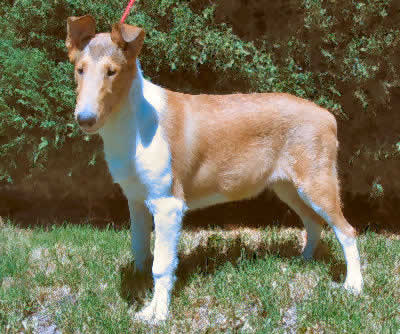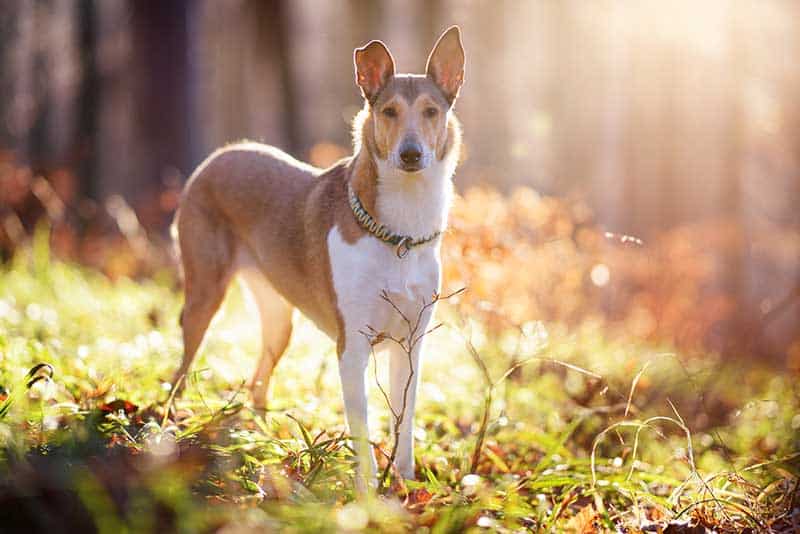
The Collie is most well known for its appearance as Lassie in the movie named after the lead dog. Lassie is a rough Collie, while the breed also comes in the smooth variety as shown in this picture. The Collie is a friendly, loyal, easily trainable, dog which makes it a great family pet.
Collies are great family dogs. This is a friendly, active, highly intelligent breed. They are easily trained and very social with children. However, owners should not expect them to perform like Lassie from the movies, since that part was played by many well-trained Collies in order to portray the ideal dog. Since the Collie can be a good guard dog, it may take some time to warm up to strangers. The smooth Collie may be slightly more active than the rough.
- Kingdom: Animalia
- Phylum: Chordata
- Class: Mammalia
- Order: Carnivora
- Family: Canidae
- Genus: Canis
- Species: lupus familiaris
Common Name(s)
Collie (Smooth or Rough), Colley, Scottish Collie, Scotch Collie, Scottish Sheepdog
Breed Type
This breed is a member of the herding dogs. These dogs were bred for herding cattle or sheep, which explains many of their characteristics. They are extremely active, intelligent, and driven to work. If not provided with an organized activity, such as herding trials or Flyball, these dogs are likely to find something less desirable to do, such as digging up gardens or chewing on shoes. Herding dogs are still currently used to herd livestock, but they can also be great pets for active owners with the time and energy to meet their needs.
Background
The Collie comes from Scotland, where it was bred as a farm dog with several purposes, including herding, droving, guarding sheep, and being a companion. It was bred from other herding dogs. The name Collie most likely comes from the Scottish word for black sheep, “colley”, though it is also possible that it comes from the word “coalie”, meaning black, or a Gaelic word meaning “useful”.
This breed is indeed useful, as it has been trained as a rescue, guide, movie, and guard dog. It is said that their popularity is partly due to the fact that Queen Victoria owned several Collies at Balmoral Castle in Scotland. Additionally, the rough (long-haired) Collie is widely popular, thanks to Lassie, a popular movie character.
Smooth Collies are more popular in Great Britain than in the United States, though they have been gaining popularity in the U.S. The Collie was first shown in the U.S. in 1877.
Description
The Collie has a large, lithe body. It weighs 55-80 pounds and stands at 22-26 inches at shoulder height. The head is long, thin, and wedge-shaped. The eyes are almond-shaped and brown, blue, or in blue merles (blue with black splotches). The nose is black and the ears are moderately large and semi-erect (folded). The tail is medium-length
The only consistent difference between the smooth and rough varieties is the coat type. The smooth Collie has a short, flat double coat, while the rough Collie has a long, straight double coat, with a luxurious mane. In both varieties, the hair on the head and legs is short and smooth.
The Collie coat comes in three colors: sable and white, tricolor, and blue merle. They can also be predominantly white combined with any of the three previously listed color types. The Collie’s typical lifespan is between 10 and 14 years.
Care and Feeding
Collies do not generally require a specialized diet. However, they do tend to overeat, and may need a diet designed for weight loss if they become overweight.
Smooth Collies require little grooming. A brief weekly grooming is sufficient during most of the year, with slightly more frequent brushings during the shedding season. Rough Collies need at least 2 or 3 grooming sessions, approximately 20 minutes each in order to maintain their magnificent coat.
Collies need regular checkups. Vaccinations are due as follows:
- 6-8 weeks: Distemper, Leptospirosis, Hepatitis, Parainfluenza, Parvo, and Corona virus (DHLPPC)
- 10-12 weeks: Second DHLPPC
- 14-16 weeks: Third DHLPPC and rabies
- Annually: DHLPPC and rabies booster
Housing Your Dog
The Collie is an active dog that needs some room to roam. A large yard in a rural or suburban area is ideal for this breed.
Social Behaviors
The Collie is a friendly dog that does well with adults and children. It will bark at strangers, though it quickly warms up to them.
Handling and Training
The Collie can benefit from training at a young age. Puppies can be rambunctious and mischievous, which calls for obedience training in order to prevent problems as the dog develops.
Activities
The Collie is active and intelligent, and enjoys all types of outdoor activities.
Breeding/Reproduction
Since the Collie is a popular breed, it is important to buy from a reputable breeder, since some unscrupulous breeders produce dogs with health and temperament problems. Litter size is approximately 6-10 puppies.
Common Health Problems
Possible health concerns include progressive retinal atrophy and Collie eye anomaly. Progressive retinal atrophy causes night blindness first, and then day blindness. There is no treatment for this disease, but many dogs adapt well to blindness, with few signs of the ailment, as long as they are in a familiar setting.
Collie eye anomaly (CEA), also known as scleral ectasia syndrome or collie ectasia syndrome, is an inherited disorder in which the eye tissue is not properly formed in the fetus. Though it was originally found in the Collie, it can also be present in Australian Sheepdogs, Border Collies, and Shetland Sheepdogs. The anomaly can cause a variety of eye defects, including detached retinas, optic nerve anomalies, and a loss of retinal cells. The vision impairment that this disorder causes can be mild to severe. Currently, there is no treatment for CEA.
Prevention consists of selecting dogs without the anomaly for breeding.
Availability
Collies are available from local breeders and breeders on the internet. Prices range from about $150-250 for adults, $300-700 for pet quality puppies, and $800-1000 for show or breeding quality puppies.
References
American Kennel Club, The (2006). The Complete Dog Book, 20th ed. New York: Ballantine Books.
Fletcher, W. R. (1977). Dogs of the World. Toronto: Ridge Press.
Larkin, P. (2002). The Ultimate Encyclopedia of Dogs: Dog Breeds & Dog Care. London: Hermes House.
Mehus-Roe, K. (2005). Dog Bible: The Definitive Source for All Things Dog. Irvine, California: Bowtie Press
Tortora, D. F., Ph.D. (1980). The Right Dog for You: Choosing a Breed that Matches Your Personality, Family, and Lifestyle. New York: Simon & Schuster.
Pet Education, www.peteducation.com (2007). Foster & Smith Inc. Author: Ruth Bratcher
Featured Image Credit: Harald Kreuzer, Shutterstock
